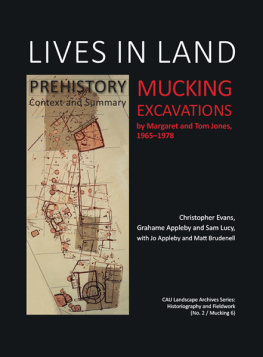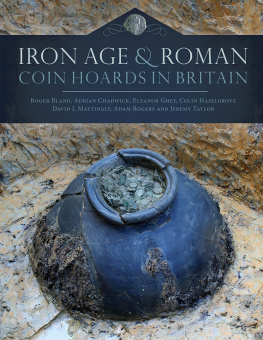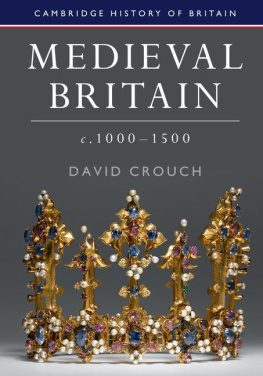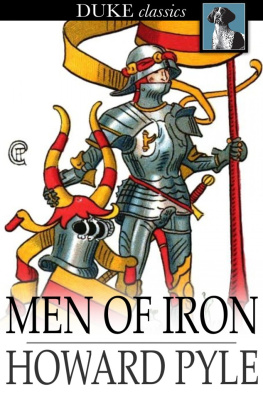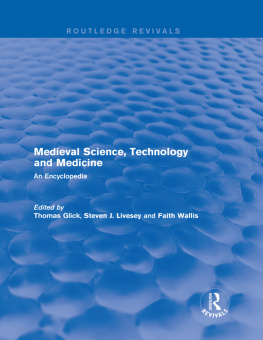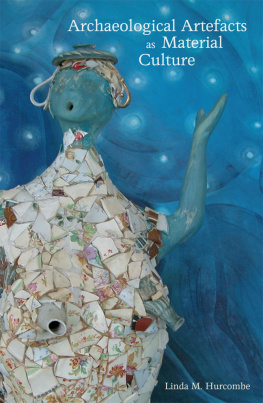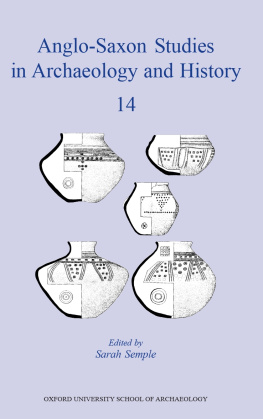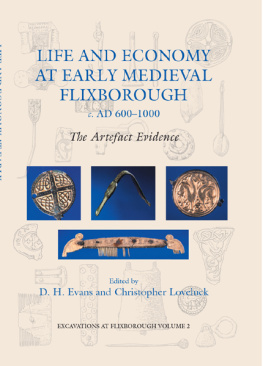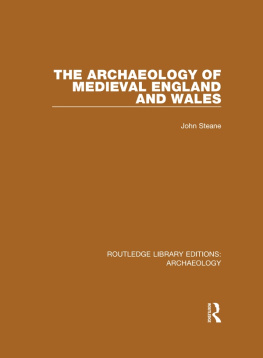Ironwork in Medieval Britain
An archaeological study
by
Ian H Goodall
THE SOCIETY FOR MEDIEVAL ARCHAEOLOGY
MONOGRAPH 31
2011 The Society for Medieval Archaeology and authors
ISBN 978-1-907975-45-5 (pbk)
Edited by Christopher Gerrard
Published 2017 by Routledge
2 Park Square, Milton Park, Abingdon, Oxon OX14 4RN
711 Third Avenue, New York, NY 10017, USA
Routledge is an imprint of the Taylor & Francis Group, an informa business
This publication has been made possible by a generous grant from English Heritage
The Society for Medieval Archaeology
www.medievalarchaeology.org/publications
Cover: Image from the Holkham Bible Picture Book, c 1325-30, The British Library Board (Add 47682)
Contents
Guide
This monograph is the publication of the late Ian Goodalls doctoral thesis on medieval ironwork in Britain which was submitted to the Department of Archaeology, University College, Cardiff, in 1980. Thirty years on, it remains the definitive survey of iron tools and other fittings in use during the period c 1066 to 1540 AD. Exceptional in a north-western European context for its range and coverage of artefacts from both rural and urban excavations, much of the material described here was recovered during rescue projects in the 1960s and 1970s funded by the State through the Ministry of Public Works and Buildings and their successors. It immediately established Ian as one of Britains leading authorities on all things ferrous and later medieval.
Only a month before Ians unexpected death in 2006, I met with him to discuss a report he had been preparing on the metalwork finds from Clarendon Palace in Wiltshire. As he worked his way through fragments of medieval arrowheads and knives, modern bicycle bells and lawn-mower blades, I asked why he had never published his thesis. Ian explained to me then that, after leaving Cardiff, his career with Royal Commission on the Historical Monuments of England and latterly English Heritage had been as an architectural historian rather than any strictly academic or archaeological enterprise and, although he had continued to compile reports on assemblages all the while, he had just never had the time to sit down and update his original work. By the time we had time to think more seriously about how his thesis might be brought to a wider audience, Ian had gone.
Certainly there is neither academic nor professional reason why his thesis should not now be published, indeed it is a work ideally suited to wider dissemination because it is relevant, useful, and difficult to access. The text contains almost everything necessary to identify, date and understand medieval iron objects. In scope and detail there is still no published parallel and, as such, it will be essential for almost any archaeologist working in later medieval archaeology, particularly in the fields of excavation, finds study, museums and research.
That said, a thesis serves a very different purpose to a published text and, although this monograph is faithful to the original as far as is possible, some changes have been necessary. In the first place the whole typescript was re-typed, and I am grateful for a small grant from the Society for Medieval Archaeology who paid for this task. Thereafter, English Heritage sponsored the editing, re-setting and final publication and, without their intervention, this project could not have been completed. The task of preparing the monograph for publication has been undertaken by Alejandra Gutirrez. The main challenge has been to update as many of the bibliographical references as possible because, of course, most references in the original thesis refer to then unpublished reports which have since appeared as articles and monographs. The dating of the Winchester finds has also been updated here in those few cases where the published reports (Goodall 1990) offer a different date to that thought correct at the time of writing the thesis in 1980. A list of Ian Goodalls major publications on metalwork is also provided arranged by date. This new bibliography should be of tremendous value to all those researching medieval metalwork and in search of further bibliography and parallels.
Finally, there have also been changes to the format. Ians original thesis comprised three volumes: text, catalogue and figures, which were arranged into chapters according to object type, covering all types of iron artefacts and tools except weapons, armour, arrowheads and spurs. For this publication, the three original volumes have been re-combined by theme, rather than keeping the catalogue as an appendix at the end of the text. This will allow the reader to check illustrated examples and read descriptions more comfortably within each chapter and theme rather than constantly shuffling pages. Some re-drawing of the finds has also been undertaken where the quality of the originals has faded. I would like to thank Norfolk Museums and Archaeology Service for their permission to use the drawing for D1 (). I am grateful too to John Clark, formerly of the Museum of London, for adding the preface.
Christopher Gerrard
October 2010
Ian Goodall and the study of medieval ironwork
The name of Ian Goodall is surely known to anyone who has consulted archaeological reports on medieval sites in Britain published in the last 30 years or so. It will be even more familiar even if they never met him or benefited from his advice to those who have themselves faced the task of contributing the small finds section to such a report. For it is impracticable, or at least unwise, to write a report on excavated medieval iron artefacts without referring to at least one and probably several of the many such reports Ian himself wrote between 1970 and his early and unexpected death in 2006. I see, for example, that I and the other contributors to a volume on medieval horse equipment from London, published in 1995, listed in our joint bibliography some seventeen of his articles; the introduction to the second edition added another. Moreover, it may be revealed, Ian was the referee asked by English Heritage to assess the merits of that publication at typescript stage. His extensive and detailed comments were of immense value to the authors.
Most of Ians published contributions to the subject were simply titled Iron objects, or a variation of that misleadingly simple designation; many ran to less than a dozen pages. But their small scale belies the wealth of knowledge and experience that lay behind the authors ability to identify and to diagnose the significance of sometimes heavily corroded and not immediately recognizable iron objects, and to set them in their historical context.
Ian Goodall was born in York in 1948, and in 1966 went to University College Cardiff to study archaeology. After graduation, he went on to begin the research that was to culminate in the award of a PhD for his thesis Ironwork in Medieval Britain: an Archaeological Study . However, Ian was still engaged on this work when in 1972 he returned to York to take up a post with the then Royal Commission on the Historical Monuments of England (later to be amalgamated with English Heritage). While contributing to major and productive research and publication projects on the buildings of York and of North Yorkshire for the Commission, he made time not only to travel extensively to study groups of medieval ironwork from excavations and in museum collections, but to begin the writing of the series of specialist reports on iron finds for which he remains so well known the first to be published (I think) comprising the material from excavations carried out between 1970 and 1972 at Waltham Abbey, Essex.





